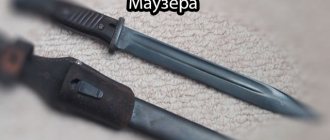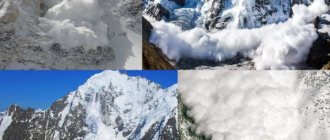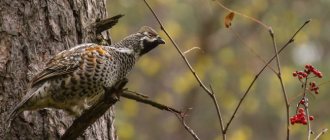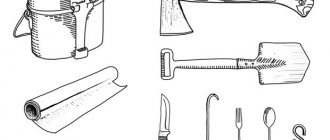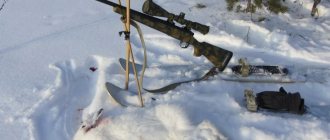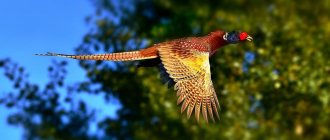HOW TO BEHAVIOR
•As a rule, a lot depends on the hunter himself. His character, willpower, poise. Heat, haste, and ill-considered actions are completely unacceptable. How many good, classy hunters died from haste?
Expert opinion
Makarov Igor Tarasovich
Hunter and fisherman with 20 years of experience. Wildlife lover
I remember at the condolence meeting the huskies grabbed a sable on the other side of the taiga river. It was early morning and foggy. I, too, slowly began to cross the damp aspen to the opposite bank. The barking is reckless, in a hurry, the sable would not have gone further.
But I feel that slipping in rubber boots on slimy, damp aspen is as easy as shelling pears. Has stopped.
I'm wondering what to do next.
And then my nephew, apparently, instinctively understood my condition and shouted for me to sit astride a tree and get over it. That's exactly what I did. Everything worked out fine. What if he thundered down with the gun (3-4 meters) onto large branches? And here is another incident while hunting with hounds.
The hunter with dogs on leashes began to cross the ravine along the crossbar and, slipping, fell down. The dogs were hanging on leashes.
Squealing, screaming. I reached for the leashes and cut them with a knife.
The dogs jumped out of the ravine. It’s good that the hound didn’t break his legs and the gun didn’t fire. It is necessary to weigh the risk when overcoming a quagmire or water hazard. Slough in the swamp is the most important thing. 2.5–3 meters, durable. When crossing, we always take life jackets (buoys) and take off the swamp pads.
•Anything can happen while hunting. Products may run out. G. Fedoseev - researcher Sayan said that in the taiga, those who have learned to replenish food and arrange decent housing survive.
It is always advisable to have a supply of fishing line, hooks, sinkers, and nylon mesh with you. At the very least, you can catch some fish, and there will be no threat of hunger.
You can also always hunt for birds if there is an urgent need. Let it not be wood grouse or black grouse. Hazel grouse, kuksha, nutcracker or thrush can always be successfully caught.
We had a case with a forester when his food and basic fishing gear were taken away by mistake. For two weeks he ate fish caught with a fishing rod: a hook and line. He told me that he was ready to get into the water in any case if the hook got caught. He was his only one.
Another hunter got lost in the swamp. The products have run out.
He made a mistake in the direction of movement and went 90 kilometers away from his home. When the sun appeared on the 5th day, he got his bearings and walked in the right direction.
Expert opinion
Makarov Igor Tarasovich
Hunter and fisherman with 20 years of experience. Wildlife lover
But my strength was running out. The man was strong, and in the second week he came out to housing. In the morning there was fog, and he did not notice the village; exhausted, he fell 10 meters from one granny’s garden. It's good that she saw him.
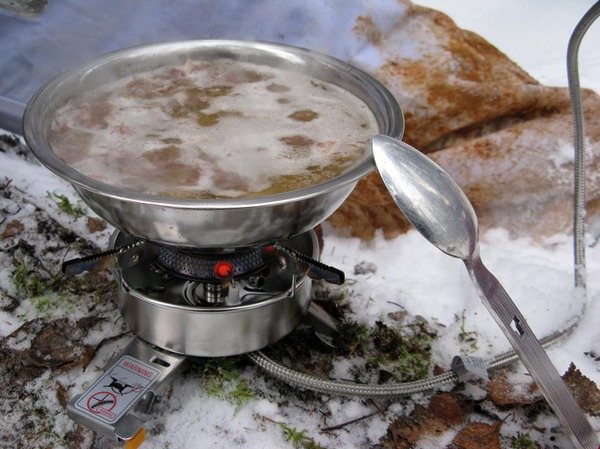
My nephew and his friend also suffered because they traveled very far from their home on the Buran. Their Buran broke down.
There was little food - they hoped for a supply in the winter hut. Everyone managed to break a ski.
They hesitated for a long time, walking on one ski. We spent the night by the fire. But people, of course, are accustomed to such tests. Exhausted, but they made it to their home.
If only I had a pinch of small nails in my pocket, it would be possible to mend the pieces of the ski and go normally.
These examples convincingly show that you cannot confidently rely on food, weapons, tools, and bedding that are in the winter hut or in transport. You can completely rely only on those products, weapons and equipment that are directly on you.
Remember Fedoseev’s. His guide Ulukitkan carried everything he had with him. And until the end of the hike, he did not throw away an empty bottle, a cartridge case, or a ball of twine. In the forest, far from housing, everything can be useful.
This is interesting: How to remove and straighten a fox skin
In advance, you need to master the methods and techniques of providing first aid. It's good if a medical professional can help you.
Learn to understand the effects different medications have on the body. And it is imperative to be able to provide assistance to a drowning person, with burns, dislocations, sprains, fractures, frostbite, colds, bruises, bleeding.
Be able to pull out a splinter, remove a speck from under your eyelids, perform artificial respiration.
The dark coniferous closed forest, known in Russia under the Mongolian name “taiga”, is called the “green sea” in a famous song. In many ways, this comparison is correct: it’s easy to get lost in the taiga, but surviving is not so easy for an unprepared person.
Therefore, you should prepare for a meeting with the taiga no less carefully than for a war. Your survival in the taiga begins at home. Proper preparation largely determines whether you come back.
Some of the tips below are of a general nature and relate to survival on land in general. Of course, taiga, tundra or desert have their own specifics, but nevertheless there are universal rules.
Moneybox of knowledge
With all the seemingly abundance of water, fuel and food, the taiga is not the most comfortable place for a person who finds himself alone with nature. Therefore, as, indeed, in any other natural area, it is necessary to take care of constructing shelter and lighting a fire. And only after this, soberly assess the situation, your capabilities and start searching for food. Hunting and fishing are not the first and most important thing to do first, since quickly making fishing gear, setting a snare or catching fish is not at all easy. If so, then you need to look for edible plants. There are not many of them in the taiga, but they exist and we must learn to look for and recognize them.
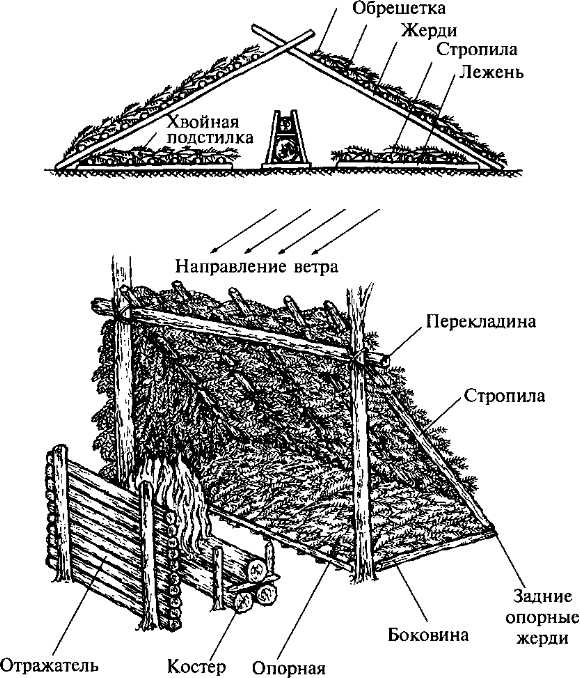
Wild, edible plants are eaten raw, boiled, dried, baked and fried. Some are used to make salads, others are used to make soups, others are used to prepare second and third courses, others are used to make flour and bake flatbreads, and others are used to make drinks. From early spring to late autumn, you can find edible plants that can not only satisfy hunger, but also compensate for the lack of vitamins, mineral salts and trace elements that are so necessary for a person in an extreme situation. And this list will be complemented by vegetable proteins and fats: mushrooms and nuts. Mushrooms appear in the second half of summer. This is a great help in nutrition. Although they are a low-calorie product, they contain proteins and carbohydrates. They are baked, fried, boiled and salted.
The false white mushroom of coniferous forests has a very bitter flesh that turns red at the break. False chanterelles have copper-red or orange caps, unlike the yellow caps of real ones. False honey mushrooms do not have the characteristic lamellar ring on the smooth stem, and there are no scales on the cap. The flesh of false mushrooms is yellow at the break and has a bitter taste, and the plates have a purple tint, yellow or greenish-brown. To protect yourself from mushroom poisoning, it is best not to eat mushrooms that you doubt are edible. But even completely edible mushrooms, if they are stale, overripe, or have been cooked in the air for a long time, can lead to very serious poisoning.
Edible mushrooms of the taiga zone, which are easy to recognize, are, first of all, boletus (they appear at the end of June), then chanterelles, russula, in mid-July - boletus, boletus, pine pine, boletus mushroom, and honey mushrooms appear in the fall. It is not recommended to fry or boil milk mushrooms, saffron milk caps, valui and similar mushrooms - they are only good for pickling.
There are also so-called conditionally edible mushrooms in the taiga. They grow, as a rule, on the edges and clearings of coniferous and deciduous forests and in places of forest fires. These are morels - real and conical, ordinary and giant. They appear in April - May and are the very first spring mushrooms. When cooking them, you need to drain the boiled water twice and only then fry or simmer.
Most often, mushrooms grow at the foot of trees on the northern side, in open forests on sloping ridges, gentle slopes of shallow ravines, in upland groves, and on flat sunny hills. They are not found in thick grass and dense forest. High-calorie foods are ant pupae or so-called ant eggs. They can be collected in the warm season in anthills near the surface. For quick collection, the following method is used: spread a shirt or jacket in the sun and tuck the edges, placing twigs under them, i.e., create shelter from direct sunlight. Then they scatter part of the anthill on the jacket. In a few minutes, the ants will drag all the pupae into the shade, under the folded edges of a jacket or shirt.
In summer you can collect snails and slugs, pupae of solitary bees, which are found in the stems of raspberries, blackberries and elderberries. In winter, pupae of the woodcutter beetle can be found in the stumps of fallen trees and under the bark. In rivers, even in winter, from under the ice, you can get bivalve shells of toothless and pearl barley. Providing water in the taiga zone and wooded and swampy areas does not present any difficulties. Animal trails will indicate watering places.
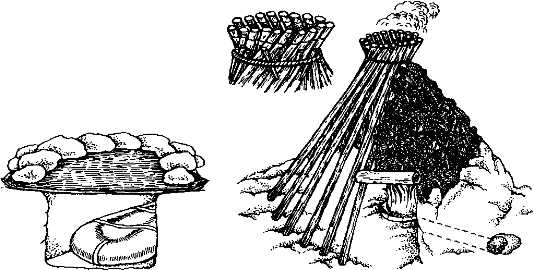
Shelter Daylight hours are short in winter, and it is necessary to think about overnight accommodation in advance. Organization of a long-term (several days) or temporary (one night) overnight stay is fundamentally different from each other. A stationary, long-term camp involves the construction of a serious, maximally insulated shelter.
The criteria for choosing a place for a camp are protection from the wind, since the wind, even a weak one, sharply increases the effect of frost, so it is best to locate in dense forest or a small hollow, avoiding open spaces, hilltops, large meadows, bare slopes; It is advisable to position the fire so that some natural obstacle is located on the windward side: a small rock, stone, blockage of trees, etc., they will not only protect the fire from the wind, but will also serve as a heat-reflecting screen; take into account that high rocks and stones should not hang over the bivouac site, since a lump of snow or a small stone can fall off them at any moment;
take into account the availability of fuel for the fire nearby in sufficient quantities so as not to look for it in the dark, and stock it in advance; do not make a fire on the surface of deep snow without constructing a deck and do not make it under trees, from whose branches melted snow may fall onto the fire and extinguish it; start searching for a place for bivouac and long-term camp long before dark; do not rush while setting up a bivouac, as this will inevitably affect the quality of the shelter, lead to repeated repetition of the same actions, exhaustion of strength and the emergence of a feeling of despair and doom. The destruction of a poorly made shelter will lead to the most tragic consequences.
If you nevertheless find yourself in an emergency situation at dusk or even complete darkness and the construction of a serious shelter in this situation is impossible, then the first thing that needs to be done is to clear, preferably to the ground, an area for a fire and overnight accommodation measuring approximately 2 x 3 m. Then light a large fire there to warm the top layer of soil. Since you will be busy with physical work all the time, it is advisable to take off some outer clothing to avoid sweating. TO
When the fire is lit and you can rest, taking off your clothes and warming them up over the fire will be very helpful. Naturally, you need to prepare a lot of firewood, otherwise it will quickly burn out and all your efforts will be in vain. After an hour and a half of burning a strong fire, you can move it to the side and lay out the spruce branches of any coniferous trees (preferably from spruce - it is warmer), collected in advance, in the free space (after thoroughly clearing it of coals).
Warmed ground covered with spruce branches, a fire and even a shallow hole in which you lit it will give you the opportunity to spend the night in relative warmth. But you will only have to sleep in fits and starts. Firstly, the fire must be maintained at all times, and secondly, there is a danger of burning if the fire spreads to the spruce branches while you sleep. Experienced taiga dwellers in such cases take off almost all their clothes, lay some of it under themselves, and lay some of it in a roller on the side of the body opposite to the warmth of the fire.
This method will really protect against the possibility of burning, since the naked body reacts sensitively to the amount of incoming heat and when it increases, the person wakes up and moves away from the fire. In the morning you can begin building a long-term shelter. It is best to make a snow house or a snow cave. Snow has great thermal insulation properties, and in such a cave, even without additional heating, it will be much warmer than just near a fire or under a canopy (hut).
An ordinary pine, cedar or spruce torch lit in a snowy house will provide not only light, but also warmth. When building a snow shelter, there is one rule: the smaller the internal volume, the warmer it is. Of course, it is not very comfortable in a cramped shelter, but cramped space should be preferred to cold, since the larger the area of the walls, the sooner the cold will penetrate through them. Snow shelters are divided into two types: open and closed. An open type shelter is mostly temporary - a snow pit covered with poles and spruce branches, a trench (hole) under a tree, it can be made around the trunk, a snow hut on shallow snow.
Chum With a very thin snow cover (2-3 cm), which has turned into a strong crust, you can build a snow chum from poles and thin snow slabs. The most lethal, durable and warm shelters can be considered closed-type shelters, which take longer to make, but which can also last longer. Closed shelters include a snow cave, den and hole. It will not be possible to make a snow igloo in the taiga zone due to the lack of dense snow for making large snow bricks. It is best to make snow caves in taiga conditions. One person can dig it up in one to two hours. For all its structural simplicity, the cave will protect you from the cold no worse than an igloo. A snow cave is dug on slopes with deep, at least 1.5 m thick, snow cover - where there is no possibility of an avalanche, even a very small one. In an area with little snow, a snowdrift suitable for constructing a cave can be found near any natural obstacles: near lonely rocks, stones, the slopes of ravines, steep banks, or a large fallen tree. In these places, the wind rake and compress the snow masses into a dense monolith. Snow cave Before starting construction, you need to make sure that there are no stones, rocks, or groundwater under the snow. This can be done with a long stick, piercing the snowdrift in several places to a depth of 1.5-2 m. When working inside the snowdrift, firstly, you need to take off excess clothes so as not to get wet, tuck the skirts of your jacket or shirt into your pants, button up all pockets and zippers, release the trouser legs over the boots. Tie your pants legs and jacket cuffs tightly to prevent snow from getting under your clothes. Secondly, lay branches or spruce branches under yourself, and if there is nothing suitable, then try to sit on one bent leg so that the area of contact between clothes and snow is minimal. The construction scheme is simple. First, they knock out a hole in the snow with their feet, then they dig a narrow tunnel in the snowdrift using a stick, flat wood chips, etc. The dead-end end of the tunnel is expanded upward to the required size. Snow from the tunnel is constantly shoveled out without accumulating it near you. If the cave is on a slope, then the waste snow is thrown down with a “scooter”.
The initial stage of construction is the most difficult and “wet”, but as the size of the cave increases, it becomes easier to work in it. The warmest and most comfortable will be a cave built according to the classical design. A narrow hole with a diameter of 50-60 cm goes horizontally into the snowdrift for about 1 m and then rises at an angle of 60°-90°, expanding in either direction to the desired size. The ceiling of the cave should be a deep vault. The volume of the cave is limited only by the height of the snowdrift. But the larger the cave, the thicker the roof should be and the deeper the semicircle of the vault. The ability to store heat in such a cave is explained by the fact that its entrance is located much below the floor, cold air goes outside, heated air is retained inside, forming a kind of thermal cushion.

Snow den A snow den is usually built in windfall taiga, in deep snow. Fallen trees with a highly developed root system are good for snow dens, where a niche filled with snow is formed between the trunk, roots and ground. Blocks of several trees, tightly linked by branches, are also convenient. Such rubble often forms blowouts with a depth of snow cover of 2 or even 3 m. A den is dug in the same way as a cave. The trunks and branches act as load-bearing reinforcement supporting the ceiling. It should be taken into account that in dense forests the snow cover is fragile and a cave built without a frame can easily collapse. When building a den, you need to make sure that the trunks of fallen trees under which the shelter is built are held firmly and will not fall on your head. Temporary shelter for spending the night while moving can also be made in the form of a hole, when spending the night without a fire is expected due to current circumstances: a snowstorm, loss of coals for lighting a fire, etc. The hole is dug in a shallow snowdrift. Its diameter should not exceed 50 cm. If the length of a snowdrift is more than 3 m, then its width may not exceed 1 m, which is quite enough to build a hole. It is important that the snowdrift is “leaned against” something, then you can dig along it. The height of the hole is calculated so that the person lies in it entirely above the entrance, that is, in a “cushion” of warm air. The bottom of the hole is lined with spruce branches, branches, and poles. During a snowstorm or heavy snowfall, you should not take refuge in holes directed deep into the snowdrift. If the entrance is blocked with snow, then it will be almost impossible to turn around in a narrow hole, and it is not always possible to kick out the compressed plug with your feet. It is better to make a hole parallel to the snowdrift: in case of danger, knock out the side wall and go outside. Snow hole In any case, be it a snow cave, snow den or hole, do not forget to make a small ventilation hole to remove combustion or respiration products. When moving, it is best to equip an overnight camp near a fire with a canopy of poles covered with spruce branches and a “nodya” type fire in front of the entrance. Prevention of possible diseases
Various injuries can only be avoided if all safety rules for movement and personal hygiene are observed. And as has been repeatedly said, this is caution when moving among fallen trees, dense thorny bushes, on kurumniks and stone screes, and crossing rivers. Severe burns are possible from clothes catching fire while sleeping near a fire, sparks getting on the face and eyes, frostbite in strong winds, etc.
Sprains, fractures, and bruises are possible, which is very dangerous when crossing deserted areas. But no less dangerous are the consequences of bites from ixodid ticks, carriers of a terrible disease - tick-borne encephalitis. Such infection, by the way, is also possible through the bites of mosquitoes and horseflies, although much less frequently. This disease occurs when bitten by a tick between May and the end of July. At the end of the first, sometimes second, week after a tick bite, the body temperature rises to 39 ° C, accompanied by severe chills, severe headache, severe drowsiness and lethargy. Paralysis may then develop, and death occurs in 30% of cases.
Ticks appear in early spring in thawed areas at an average daily temperature of +4...+5 °C and are most active in late May - mid-June, but their bites can be dangerous in July and August. The tick especially loves animal trails in shaded forest areas, bush thickets and deciduous forests. But it is also found in open areas covered with tall grassy vegetation. Hungry ticks are located at the tips of the side branches of plants and grasses, clinging to the clothing of a passing person or to the fur of an animal. Ticks are active at any time of the day and in any weather, except heavy rains.
In humans, ticks most often stick under the armpits, to the chest, back, at waist level, to the neck, behind the ears, along the edges of the hairline, and also in the groin area. The tick sticks within 5-7 hours. Its bite is painless. The tick sucks blood for 2 to 7 days. When bitten, it is very important to detect and remove the attached tick in time. For this purpose, it is necessary to regularly inspect the body, especially when crossing thickets of bushes and after a night rest. You should not tear off the tick with your hands; it is best to burn it with a small coal. The proboscis remaining in the wound is removed with a sharp object heated over fire, and one of the medicinal plants is applied to the wound. If you accidentally crush a tick, do not rub your eyes or touch the nasal mucosa until your hands are thoroughly washed.
In the period from May to early September, the vile becomes the “master” of the taiga. This is a collective local name for flying blood-sucking creatures: mosquitoes, midges, midges. They cover all living things in clouds, get into the nose, mouth, ears, and penetrate under clothes. Their bites can drive a person into a frenzy. There is practically no protection against them, other than special nets and repellents. Just as in tundra and forest-tundra conditions, you have to brush them off with a twig, fasten your clothes tightly and light a smoker in parking lots. Thin peels of wild apples are suitable for a smoky fire. Exposed areas of the body can be lubricated with a solution of clay or silt. The frozen crust will protect against bites. You can use a decoction of wormwood roots to wash your face. Twigs of wormwood, meadow chamomile, bird cherry or elderberry are hung in the hut.
To avoid colds, it is not recommended to rest lying or sitting on bare ground and cold stones. The water in taiga rivers is cold even at high air temperatures, and drinking it when you are hot while walking is extremely dangerous because of the possibility of getting a cold in your throat.
Any ailment, especially colds and sore throats, is accompanied by an increase in temperature, and this will complicate your movement and may even make it impossible. Problems can also arise due to abrasions on the legs. This often occurs from repeated crossings during the day through large and small water obstacles - the feet are constantly wet and by the evening, slight redness of the skin on the legs can turn into painful blisters. Under no circumstances should they be opened.
Read about this topic on the website:
Peculiarities of survival in mountainous areas Peculiarities of survival in the jungle Survival in arctic conditions Peculiarities of movement in uninhabited areas How to find the right road in an unfamiliar area Preparing for the transition in search of salvation Providing everyday life and personal hygiene in extreme situations
Communication is everything
It's worth starting with communication. Even in war, good communication is often more important than a machine gun. This is especially important if you are going to be far from civilization. Fortunately, modern technology provides a wide choice of tools.
Satellite phone
. Currently, rental prices have made this type of communication quite affordable for groups and even single tourists. Especially if you don’t chat on it for hours in the usual style, but save the batteries just for emergencies.
Satellite tracker
. In some ways it’s even more attractive than a phone. Smaller, more compact, cheaper, better battery life and communication due to the fact that the satellites orbit is lower. There were cases when the tracker worked where there was no telephone connection.
Modern trackers can transmit messages; in extreme cases, they usually have an SOS button. In particular, some models of Garmin navigators have the functions of such trackers.
Radio station
for communication with the “outside world” for several hundred kilometers in conditions of medium and very rough terrain, the weight will clearly surpass the phone. And weight on the road, when you have to carry everything on yourself, is often more valuable than gold. Walkie-talkies on a hike may be required for negotiations within a group.
If for some reason it is impossible to ensure reliable contact with the “mainland”, you should make sure that one of the remaining people is aware of your route and the expected time of return. Not necessarily in the form of an application to the Ministry of Emergency Situations - at least someone you know who can “raise the alarm” if those who have gone into autonomy do not get in touch for a long time.
Overnight in Taiga:
If you have to spend the night in Taiga, then you definitely need to light a fire. How to do this, see the article “Firewood for a fire.” This will give you the opportunity to keep warm and scare away wild animals. Maybe someone will think I’m wrong, but I recommend not sleeping at all in Taiga at night (if you are alone or alone) and especially in winter. Especially in winter, because if the fire goes out, then in a good frost, you may simply not wake up and freeze. Of course, this is if you had to spend only one night in Taiga for some unplanned reasons. Also remember that an animal will never approach you with a fire.
And then everything is simple: the fire should burn as long as possible, you should be warm and dry. Equip a sun lounger, build a thicker and softer bedding on the ground, usually coniferous or fir branches.
About animals, and in particular about predators, remember: Unless it is a “hunger year” and it is not already late autumn in such a year, then the animal, no matter what kind of predator it is in the Taiga, will never approach you and will always avoid you You will meet many kilometers away between him and you. He will simply leave. Or if you somehow violate their territory and the animal doesn’t like it, then he will “warn” you about it. If you hear growling, howling, etc., then do not be afraid, do not run, but take it as a warning that you need to leave this area of the forest.
In general, spending the night in Taiga is, in principle, no different from spending the night in any other forest or just in nature when you are relaxing.
Planning and fees
NZ or NAZ.
Emergency (emergency) reserve
. In principle, it is better if it is always collected from you.
Even in the life of the most peaceful man in the street, planning a trip further and more dangerous than to a beer stall, sometimes things happen. Natural disasters, terrorist attacks, man-made disasters and other vicissitudes of fate can easily make it so that the condition for survival will be an immediate escape “with what you have,” when you cannot waste a second getting ready.
Expert opinion
Makarov Igor Tarasovich
Hunter and fisherman with 20 years of experience. Wildlife lover
However, there are also many less globally catastrophic situations when it will simply be useful for you to know for sure that the things collected in the set are at the ready.
The list below is one of the emergency kit options. It should not be considered some kind of holy scripture. On the contrary, if you take the time to determine your personal minimum survival kit, it will be an additional plus for you.
Knife
. Many survival specialists (and a much larger number of Internet gurus) can write not only an article, but an entire book about choosing the “right” knife.
Like any good working tool, it is best to choose a knife yourself, “for yourself,” with an emphasis on practicality, rather than “tacticality” or beauty. The pattern of damask steel and mammoth bone carvings are great to admire in a warm office.
In the taiga, it will be important to you that the blade does not break and the handle does not slip in your hand.
And yes, there is no need to confuse a knife and a multitool. This is a separate, although also useful, item.
Fire starters
. Matches, lighter, minimal kindling.
It is easier to start a fire with a lighter, but so far they have not learned how to make them last forever - gasoline and gas evaporate, the charge in the battery is discharged. Meanwhile, even in the summer without fire... of course, you can survive, but the chances are significantly reduced.
A fire will keep you warm at night, help you signal and scare away predators, boil water, and cook food. In general, this is not a place where you should save money, especially since it’s difficult to spend a lot of money here.
Of course, these items need to be packed especially carefully to avoid getting wet.
Flashlight
. It will be useful not only in extreme situations, but also in many everyday situations. At a minimum, a simple power outage will not leave you in complete darkness.
A skein of paracord.
Or another rope of similar quality. Doesn't weigh much, doesn't take up much space. Could save a life.
First aid kit
. See what was said about the knife above. If you lack your own knowledge, consult a doctor who knows you personally. Plaster (on a roll), bandage, antiseptic - a must-have. Without fanaticism: there is no need to try to fit a medicine cabinet into the NAZ.
Roll of duct tape
, that is, tape. It's funny, but it works. Anyone who has ever returned from a hike with dilapidated shoes wrapped in tape, bought with almost all the money in the world, no longer laughs at this idea. Many vital things, with the help of adhesive tape, will be able to hold out for some time.
Other
. Needles, threads, fishhooks, mosquito and bear repellent, external batteries for electronics, and so on. Added to taste, depending on the intended route. The main thing is not to turn the NAZ into a “large hiking backpack”, the collection of which is a completely separate topic.
This is interesting: Article 20.8 of the Code of Administrative Offenses of the Russian Federation. Violation of the rules for the production, sale, collection, exhibition, accounting, storage, carrying or destruction of weapons and ammunition
And, finally, the most important item, without which it is difficult to survive anywhere. Head.
What to do, if…
Expert opinion
Makarov Igor Tarasovich
Hunter and fisherman with 20 years of experience. Wildlife lover
Even if you skipped all the previous points and found yourself in the middle of the taiga without means of communication, survival and in a freshly woven loincloth made of bark, you have a chance to survive. The first thing that destroys people in such a situation is panic.
Cold, hunger, predators or fatigue usually appear later - as a result of incorrect decisions made earlier. In this case, it may no longer matter where you are.
In September 2014, an elderly man died after getting lost in Moscow's Losiny Ostrov park.
If you are completely lonely and scared, you can hug a tree. Yes, it sounds funny, but it helps some.
What to do if you suddenly find yourself cut off from the civilized world?
Assess the situation soberly
. For example, if you survived a plane crash, consider whether it makes sense to leave the scene of the accident.
The flight route is usually known and is fully or partially tracked. Aircraft may have systems that automatically issue a distress signal.
When searching from the air, a crashed plane or helicopter is much more noticeable than a lone person or even a group of people in a dense forest. Finally, an airplane, even broken into complete trash, in the middle of the taiga, is like a whole warehouse of items necessary for survival.
Sheathing is a material for shelter, wires are a replacement for ropes for snares or even fishing line. There may be residual fuel in the tanks. Tires are a source of black smoke that is clearly visible from a long distance.
If you still need to go out, assess the situation again
. Think carefully about your route. For example, the closest housing and the most easily accessible are not always the same thing.
One of the possible options is to walk “on water”
. Any stream is not only a source of life-giving moisture in the literal sense of the word, but also a natural direction indicator.
Streams flow into rivers. Small rivers - into larger ones.
But even small rivers are often used as transport arteries - which means there is a much greater chance of meeting people near them. If possible, you can build a raft and float downstream (not forgetting to stay overnight so as not to suddenly find yourself in the open sea).
But even walking along the water is, as a rule, easier and faster than making your way through the forest.
Calculate your inventory carefully
. First of all, strength. You should not try to walk “as much as possible” during daylight hours: remember the need to prepare for the night. This is especially important in winter, on short days. Remember the basic rules for starting a fire: the wood must be dry and there must be a lot of it. So many.
Water and food
. First, try to boil it if possible. If you have the second one with you, it’s very good. You should try to stretch out the food, but, as in other points, without fanaticism. A well-fed person can walk more in a day than a hungry person can crawl.
Important: do not try to experiment with food. Use only what you know is edible. “Tasty-looking who-knows-what-berries” are not worth trying.
You can survive on mushrooms and berries in the taiga: although such a diet is not very high in calories, it is better to come out thinner than not to go out at all. The seeds of many taiga trees - pine, walnut, cedar - will also be eaten.
And finally, the most important tip. No articles, books, video lectures or other theoretical knowledge can replace personal experience.
Even the simplest hike in suburban forests with an overnight stay a couple of kilometers from the train will give you a lot. First of all, understanding your own capabilities.
Having survival skills, even if they will never be useful, is much better than learning to survive from scratch yourself in a truly extreme situation.
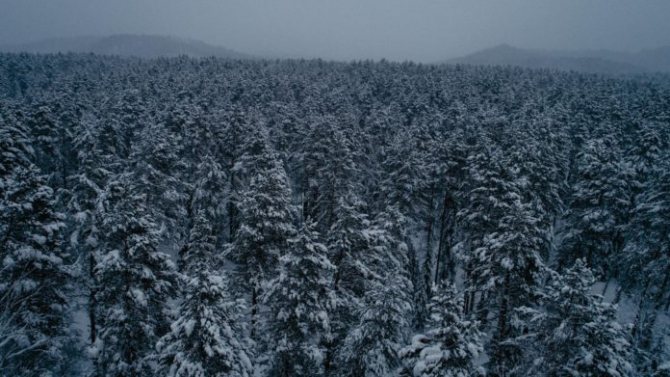
Taiga is a place with beautiful landscapes, rich forests and many dangers. For an unprepared traveler, a trip to the taiga can end tragically. Survival in the taiga in winter includes many rules that everyone who decides to conquer the northern expanses should know.
How to behave as a leader if the group gets lost in the taiga
During a campaign, different situations arise, but the success of the enterprise depends on the behavior of the leader. Therefore, it is so important to know certain rules of behavior when you cannot find the right path.
- calm down yourself and calm down other group members. You cannot panic and sow confusion in the team. It is not necessary to tell all team members about the true state of affairs. It makes sense to report what is happening only to experienced taiga residents.
- It is permissible to consult with everyone, but make decisions alone. There cannot be two leaders.
- when there is no longer any chance of finding the road, it is better to set up a camp. To do this, choose a clean and dry place so that there is visibility on all sides. The ability to store firewood and create sleeping places is also important. You need to light a large fire with a supply of spruce branches; it produces a lot of smoke, visible from the air. It is unknown how long one will have to spend in such a camp. The supply of water and food is divided into portions. The main task is to hold out until rescuers arrive.
- There’s no point in rushing around the taiga looking for a way out. It is recommended, in addition to the fire, to mark your place of stay with bright objects, for example, clothes of noticeable colors.
It is also worth carefully studying the information on what a tourist should do if he gets lost in the forest.
Features and rules of survival in the taiga
Expert opinion
Makarov Igor Tarasovich
Hunter and fisherman with 20 years of experience. Wildlife lover
Surviving in the taiga is not an empty phrase. A person who finds himself in server forests faces many dangers, and overcoming them will be precisely a matter of survival.
The main enemy of the taiga is cold. In winter, especially at night, it is extremely dangerous. The human body, trying to warm up, spends a lot of strength and energy, and frostbite and hypothermia reduce the chances of survival.
Remember that in the north there is a limited choice of natural resources, food and water. When preparing for your trip, calculate how much supplies you will need for the entire trip.
In addition, do not forget about equipment, a first aid kit, and survival items, even if you are just going to the taiga for a walk. No one knows what surprises one day in the northern forest will bring you.
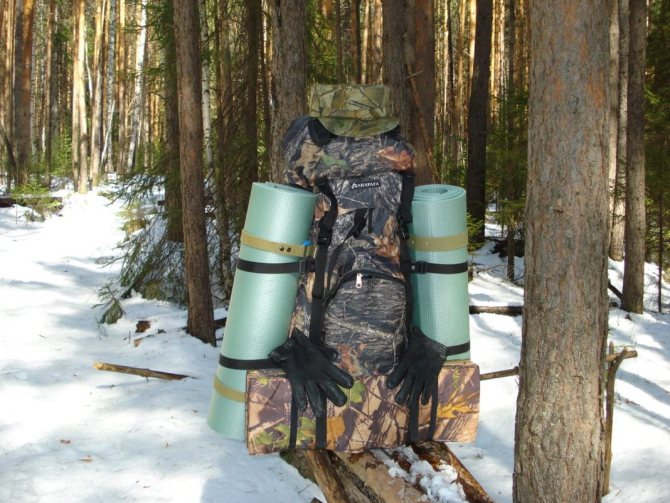
To survive in the taiga in winter, your backpack should have everything you need
Getting ready for the taiga begins with a backpack, which contains everything you need for survival, from matches to a tent. That is why the hiking bag must be of the appropriate size and accommodate the entire hiking kit. Let’s look point by point at the basic rules of survival in the taiga and what is needed to comply with them.
Dangerous insects
Poor conditions for navigating the terrain: due to the fact that all areas are similar to each other, a lost person begins to walk in circles, panics and quickly becomes exhausted.
Natural hazards where you can get hurt
Few safe food sources: Poisonous plants and berries can cause serious health problems and even be fatal. In order to survive and get out of the impenetrable thicket, a person, first of all, needs food. We will talk about methods of obtaining food in the taiga below.
Read: Five best survival kits
We select clothes and shoes
When choosing things for a trip to the winter taiga, apply the rule of “three layers”: base, insulation and top. Quality clothing will reduce heat loss and protect you from the cold.
Since the hike will take place in the winter season, choose the appropriate color of clothing. And the last rule is that clothes should be light, otherwise you will quickly get tired when walking through thick snow.
Particular attention is paid to underwear. This should be thermal underwear made from natural fabrics, possibly with fleece. Knitted and plain cotton socks and foot wraps are taken with a reserve, 8-10 pairs, in case your feet get wet and you need to change clothes.
Warm pants or gaiters are worn under overalls or synthetic pants. On top of the thermal underwear is a turtleneck with a long neck and a warm sweater or fleece jacket. It is also better to take these things with a reserve.
Expert opinion
Makarov Igor Tarasovich
Hunter and fisherman with 20 years of experience. Wildlife lover
The top layer should be made of synthetic fabrics, not blown or wet. A long jacket or fur coat will be just right, but a sheepskin coat, especially if it gets wet on top, will become very heavy and make further movement difficult.
We put a warm knitted hat or earflaps on our heads and take a balaclava with us. We insulate our hands with fur-lined mittens, take 3-4 spare pairs with us, and a scarf over our throats.
This is interesting: Night vision devices for hunting - history, design, application and selection rules
Protein sources
Of course, the best source of protein is the meat of wild animals and fish, but they can only be obtained with the help of weapons and having special skills. What to do if you don’t have anything with you?
Read: Basic safety precautions for hiking tourism: relaxing in the forest without risk
In taiga conditions, insects can become a source of protein. Suitable food:
- larvae of large beetles (which can be found in a hollow tree or in a rotten stump);
- locusts;
- grasshoppers;
- black ants and their eggs.
It is advisable to bake insects over a fire or prepare taiga stew from them (despite the unusual composition, it will be quite nutritious and will be able to maintain strength during a long journey through the forest).
Red ants are not edible - they contain a lot of acid that can harm the human body.
Necessary equipment for survival in the taiga in winter
Equipment should be not only for household work and cooking, but also for self-defense. In your backpack, be sure to put a sleeping bag, a camping mat, a piece of polyethylene about 2x2 m, and, if possible, a one-person tent.
When folded, it takes up little space, but will bring a lot of benefits. To navigate the terrain you need a compass.
Keep a flashlight and a set of spare batteries in your pocket. A small gas burner will come in handy if you are unable to start a fire, such as in heavy rain or wind.
Now let's collect survival tools:
- a small hatchet and knives, one for cutting up animal carcasses, the other for household purposes;
- pencils and markers;
- a map of the area where you are going;
- rope;
- fuel canister;
- candles;
- several boxes of matches and some lighters. Place it all in a waterproof bag or airtight container to prevent it from getting wet;
- any tools that may be useful for the construction of a temporary shed (pliers, hacksaw, small saw, plane, nails, etc.).
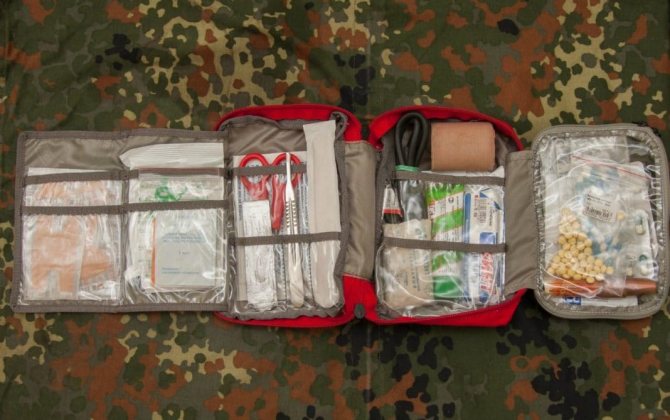
To survive in the taiga in winter, be sure to take a first aid kit
A first aid kit with a minimum supply of medications is a must. Place iodine, brilliant green, peroxide, bandages, plasters, painkillers and hemostatic agents in it. Some sorbents won't hurt if you eat something wrong.
To find your way around and communicate with the outside world, you will need a GPS navigator, a smartphone with a spare battery, a radio and a walkie-talkie.
Household utensils include a metal plate, mug, fork and spoon (or just a spoon). Don't forget about a small pot in which you can cook yushka or brew tea.
There are a lot of fish and wild animals in the taiga forests and rivers. Hunting and fishing for them will help you avoid starving if your food supplies run out. To catch, take with you a gun with spare cartridges and a fishing rod with the necessary gear. The weapon will also be useful for self-defense, if any large animal does not want to become your prey.
Experienced taiga travelers know that it is better to go north with a trained dog. Of course, it does not apply to your equipment, but taking a faithful friend with you will not be superfluous. Dogs will help in difficult situations, alert you to danger and simply brighten up your leisure time if you have to survive in the taiga yourself.
Edible plants
Edible berries are very common in taiga areas: raspberries, strawberries, blackberries and blueberries. The most important thing is to be able to distinguish them from poisonous fruits that can harm your health. In summer there are a lot of berry bushes, and finding them is not difficult, but in winter they freeze right on the branches or under the snow.
Cedar, pine and larch cones are good food: they should be knocked directly from the trees, and not collected from the ground (fallen cones will most likely be empty, since in the taiga there are many animals that eat them).
Cattail is an excellent food for humans in taiga areas. This plant grows on the banks of forest reservoirs: its roots are rich in starch, which is easily absorbed by the human body. The dug up roots can be eaten even raw, but it would be preferable to bake them over coals.
In addition to plant foods, a person definitely needs protein, otherwise there will be nothing to reinforce his strength, and getting out of the forest will become even more difficult.

